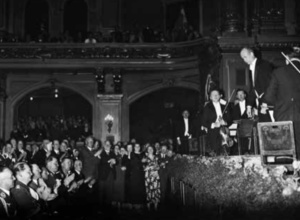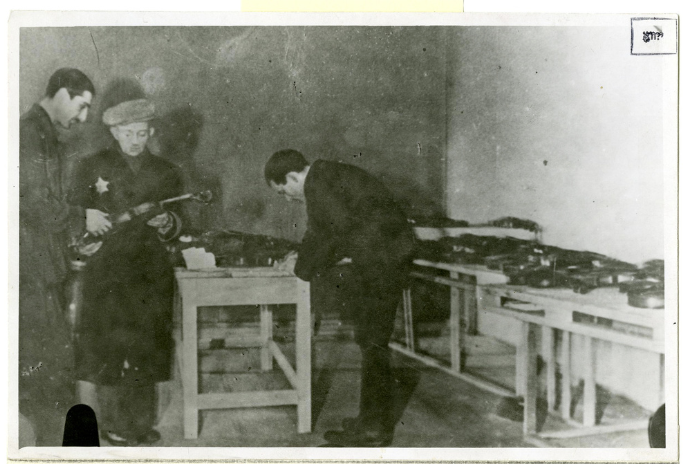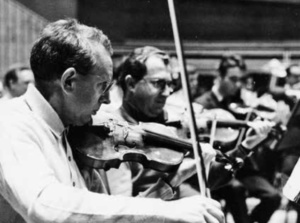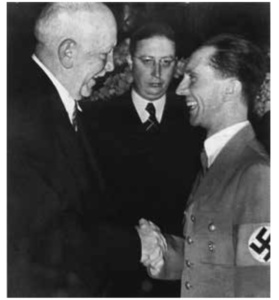Berlin-based historian Joseph Pearson has written a new book about everyday objects that tell stories from the Second World War called My Grandfather’s Knife. Of interest to our community is the story of seven Nazi-era musical instruments.
Jason Price: During your research, you discovered an open secret. Could you tell us how you discovered it?
Joseph Pearson: It was completely by accident that I discovered a trove of Nazi-era stringed instruments––procured by Joseph Goebbels’s Ministry of Propaganda at the height of the war. I was writing my book about how everyday objects told individuals’ stories from the war, and I was chatting with a friend in today’s Berlin Philharmonic, who suggested I meet Erich Hartmann, at the time the only surviving member of Furtwängler’s wartime orchestra. He has since passed away, but I had the opportunity to interview him and speak to him about his double bass. His story is extraordinary in itself––and I tell it in the book. A double bass is a cumbersome instrument to move around in a city at war. Hartmann used a baby carriage to manoeuvre it through Berlin in ruins—

Furtwängler, with Göring, Hitler, and Goebbels in the front row, 1935
Jason Price: But it was not Hartmann’s double bass which was the main discovery—
Joseph Pearson: No, discussions about the provenance of his instrument led me to research the instruments of his fellow orchestra players in the period, in particular a 1731 Camillo Camilli violin, an undated Guarneri cello, a 1734 Nicolo Gagliano violin, a 1698 Matteo Goffriller violin, a 1736 Pietro Guarneri violin, a 1761 Guadagnini violin, and a seventeenth-century Giovanni Maria del Busetto viola.
Jason Price: How were these instruments procured by the Nazis?
Joseph Pearson: The Nazis had several sophisticated programs of looting valuable instruments from around occupied Europe. They were also clever at hiding their tracks, by working through agents and giving the appearance of legality to forced sales. I do not know who owned these instruments before the war, but I have been in communication throughout my project with Berkeley scholar, Carla Shapreau, whose research centres more specifically on the question of provenance. What is important to stress is that these instruments were procured at the height of World War Two by a Ministry known for stripping victims of the Third Reich of their property. An enormous question mark hangs over their provenance. In the art museum world, the gaps in provenance would be extremely problematic, and preclude their inclusion in a collection.

Examination of confiscated violins, Łódź Ghetto, 1942[1]
Joseph Pearson: The German government. In my book, I follow a circuitous trail of the 1761 Guadagnini violin, once played by Hans Bastiaan, concertmaster of the Berlin Philharmonic during the war, to the current owner. The government has not advertised these instruments as being in their possession and when I asked, I was told: ‘we never concealed the origin of former Reich ownership of the instruments, but their history was also very rarely inquired about’.
Six of the Nazi-era instruments are now loaned to young people – the seventh is the damaged Goffriller violin in the Musical Instrument Museum in Berlin. The loan program is run by the Hamburg organisation, the Deutsche Stiftung Musikleben, or German Foundation of Musical Life, established in 1993, which oversees 200 instruments from a collection called the Deutscher Musikinstrumenten Fonds.
Jason Price: You mentioned that a 1761 Guadagnini violin guided you to the other instruments. Who played this instrument?
Joseph Pearson: I found an official announcement from 1942 in which Hans Bastiaan is given this instrument by Joseph Goebbels’s Ministry. He played the violin until his retirement. After him, it was played by Kolja Blacher, Michael Mücke, Isabelle Faust, Tanja Becker-Bender, Korbinian Altenberger, and Alexander Gilman. Ioana Cristina Goicea has played it since 2013. What struck me was how many of these talented musicians turned out to be Jewish, descendants of Holocaust victims or other victims of Nazism. And I was astonished, when I interviewed the majority, that none––save one––had known the Nazi-era history of the instrument.

Hans Bastiaan playing the 1761 Guadagnini in 1970[2]
Joseph Pearson: Some said that had they known, they would never have accepted the instrument. Others wondered why they had not asked the question themselves. Others like Korbinian Altenberger said that the ‘violin doesn’t choose its part’ and that it changed the way he played. Altenberger’s family, incidentally, was on both sides a victim of the Nazis. All the players said that it was one of the best violins they had ever had the opportunity to play. In any case, in the book, I interview each of them and record their reactions.
Jason Price: Did you know that these musicians were unaware of the violin’s Nazi-era history when you spoke to them?
Joseph Pearson: No, because the first person I spoke to, Kolja Blacher, knew some of the violin’s history already. He told me that he would have never played it had he known when he was younger. I interviewed the others assuming they also had an idea of the instrument’s history, so it was as much of a revelation to me as the musicians when I started to understand that the history had been withheld from the players.
Jason Price: What do you think should be done now with these seven instruments?
Joseph Pearson: An instrument needs to be played. As Alexander Gilman told me, you can’t just throw it into the sea. If it’s not played, then the instrument deteriorates. The government’s solution of short-term loans to young people is a good one. But there needs to be more transparency about the instruments’ Nazi history and greater efforts to discover their provenance. I am glad that Carla Shapreau is working on a book related to the subject. And, since writing the chapter on the instruments, I have been told that the Deutsche Stiftung Musikleben is doing more to inform young musicians about their instruments’ histories. Nonetheless, I am flabbergasted that these seven instruments have been passed from player to player, and for generations now, in the absence of this urgent discussion.
Jason Price: You embed the story of the instruments in a larger assessment of the Berliner Philharmonic during the war––
Joseph Pearson: Yes, I am frustrated that so much research on the Berlin Philharmonic during the war is an effort to exonerate the orchestra from being a ‘Nazi Orchestra’. The orchestra was under the direction of Goebbels’s Ministry, the same way as these programs for procuring valuable instruments were. Of course, it was a ‘Nazi Orchestra’. It was run by a Nazi Ministry. I try in my chapter to reveal the complicity of the Berlin Philharmonic with the Nazi project, as a fig-leaf for atrocity, as they toured around the occupied continent and played for the Home Front.

(Left to right) Richard Strauss, Heinz Drewes, and Joseph Goebbels in 1938
Jason Price: Could you tell us about the other objects in your book?
Joseph Pearson: The knife was an object I inherited from my veteran grandfather, an Allied soldier who picked it up in the Netherlands. I followed markings, symbols on it, to tell its Holocaust story. There is also a diary written in a forgotten handwriting that tells of a romance between a German marine and a French civilian. I also conducted the first interview with Joseph Goebbels’s wartime cook about her book of recipes. The final object is a cotton pouch sewn into a thin winter jacket by a Hungarian-Canadian Holocaust survivor.
In all of these accounts, I am fascinated by the way an everyday object becomes something like an attractor for memory, and also a strategy for getting war witnesses to tell their stories differently. And I was surprised that, from many small everyday things, such large webs could be spun. In the end, it turned out to be an enormous detective story, and I think the reader will be surprised by the discoveries.
Joseph Pearson is a writer and historian at the Barenboim-Said Akademie in Berlin. His new book, My Grandfather’s Knife is available from The History Press (UK), HarperCollins (Canada), and in audiobook format. A Spanish translation is forthcoming with Crítica / Planeta.
To purchase the book in Europe click here. For North America, here.
Notes
[1] From the Archives of the YIVO Institute for Jewish Research
[2] Photo credits: Hans Bastiaan, rehearsal in the Philharmonic under Barbirolli on November 14, 1970, for the concerts to be held on February 15-17. Original photo: R.Friedrich, estate of Hans Bastiaan.